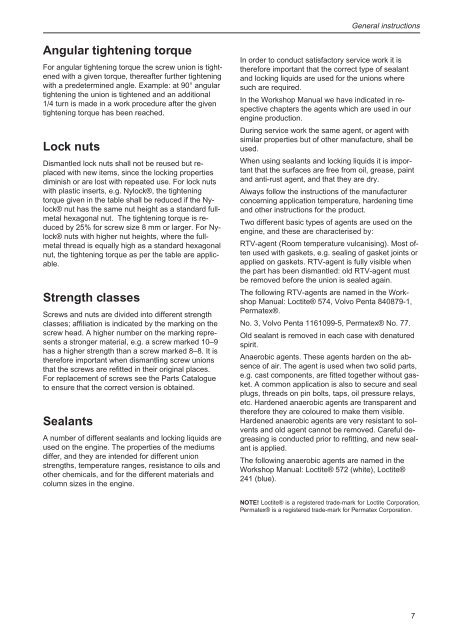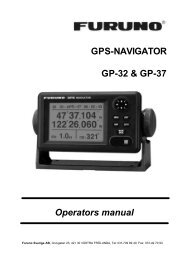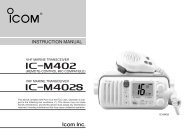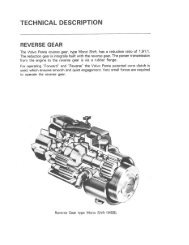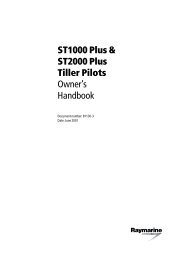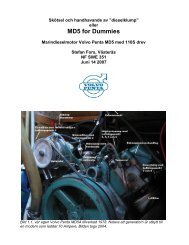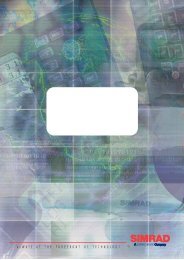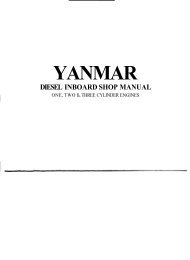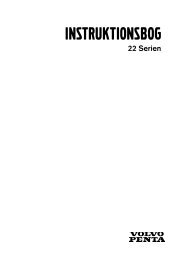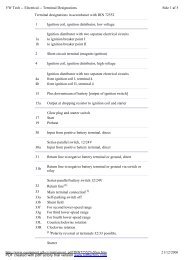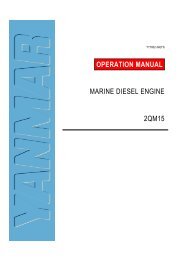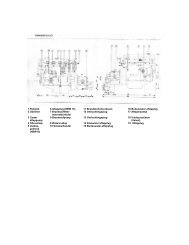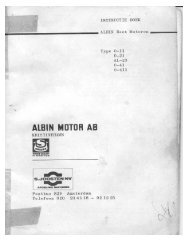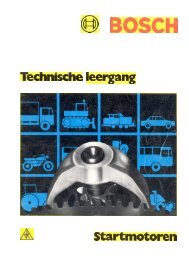General instructionsRepair instructionsThe work methods described in the <strong>Workshop</strong> <strong>Manual</strong>are applicable for a workshop environment. Theengine is therefore removed from the boat andmounted in an engine block. Renovation work whichdoes not require removal of the engine is conductedin situ with the same work methods, unless otherwisestated.The warning symbols used in the <strong>Workshop</strong> <strong>Manual</strong>(see Information on Safety for implication)NOTE!WARNING!IMPORTANT!These are in no way comprehensive, since we obviouslycannot foresee everything, in that service workis conducted under the most various conditions. Wecan therefore only point out the risks which we considercan arise as a result of incorrect handling duringwork in a well-equipped workshop with workmethods and tools which are proven by us.In the <strong>Workshop</strong> <strong>Manual</strong> all the work procedures forwhich there are special Volvo Penta tools are conductedwith these. The special tools are speciallyproduced to facilitate the most safe and rational workmethod possible. It is therefore the responsibility ofpersons using other tools or another work methodthan that which we recommend to ensure that no riskof personal injury, material damage or malfunctioncan occur.In some cases there may be special safety instructionsand user instructions for the tools and chemicalsnamed in the <strong>Workshop</strong> <strong>Manual</strong>. These instructionsshall always be followed and there are no specialinstructions for this in the <strong>Workshop</strong> <strong>Manual</strong>.By means of taking certain elementary proceduresand using a modicum of common sense, most riskfactors can be prevented. A clean workplace and aclean engine eliminate many risks both of personalinjury and malfunction.Especially during work on the fuel system, lubricationsystem, induction system, turbo, bearing unions andsealing unions, it is of the greatest importance thatdirt or foreign particles do not get in, since this canresult in malfunctioning or shorten the repair servicelife.Our joint responsibilityEach engine consists of a large number of interactivesystems and components. The deviation of a componentfrom the technical specification can dramaticallyincrease the environmental impact from an otherwisefirst-rate engine. It is therefore of extreme importanceto maintain the given wear tolerances, that systemscapable of adjustment receive the correct setting,and that Volvo Penta Genuine Parts are used for theengine. The time intervals in the engine’s maintenanceschedule must be followed.Certain systems, e.g. components in the fuel system,may require special competence and special testequipment. Certain components are sealed at thefactory for environmental reasons. Work on sealedcomponents must not be conducted unless authorisationfor such work is held.Remember that most chemical products, incorrectlyused, are hazardous to the environment. Volvo Pentarecommends the use of biologically decomposing degreasingagents for all cleaning of engine components,unless otherwise stated in the <strong>Workshop</strong> <strong>Manual</strong>.When working on board a boat pay special attentionto make sure that oils and washing residue arehandled correctly for destruction, and do not unintentionallyend up in the nature, e.g. in the bilge-water.Tightening torqueTightening torque for vital unions, which should betightened with dynamometric wrenches, is listed in“Specifications: Tightening torque” and indicated inthe manual’s work descriptions. All torque indicationsare applicable for cleaned threads, screw heads andmating surfaces. The torque indications refer to lightlyoiled or dry threads. If lubricants, locking liquids orsealants are required for the screw union, the type isindicated in the work description and in “Tighteningtorques”. General tightening torque as per the tablebelow is applicable for unions where special torqueindications are not given. The torque indication is astandard value and the union does not require tighteningwith a dynamometric wrench.SizeTightening torqueNmft.IbM5 6 4.4M6 10 7.4M8 25 18.4M10 50 36.9M12 80 59.0M14 140 103.36
General instructionsAngular tightening torqueFor angular tightening torque the screw union is tightenedwith a given torque, thereafter further tighteningwith a predetermined angle. Example: at 90° angulartightening the union is tightened and an additional1/4 turn is made in a work procedure after the giventightening torque has been reached.Lock nutsDismantled lock nuts shall not be reused but replacedwith new items, since the locking propertiesdiminish or are lost with repeated use. For lock nutswith plastic inserts, e.g. Nylock®, the tighteningtorque given in the table shall be reduced if the Nylock®nut has the same nut height as a standard fullmetalhexagonal nut. The tightening torque is reducedby 25% for screw size 8 mm or larger. For Nylock®nuts with higher nut heights, where the fullmetalthread is equally high as a standard hexagonalnut, the tightening torque as per the table are applicable.Strength classesScrews and nuts are divided into different strengthclasses; affiliation is indicated by the marking on thescrew head. A higher number on the marking representsa stronger material, e.g. a screw marked 10–9has a higher strength than a screw marked 8–8. It istherefore important when dismantling screw unionsthat the screws are refitted in their original places.For replacement of screws see the Parts Catalogueto ensure that the correct version is obtained.SealantsA number of different sealants and locking liquids areused on the engine. The properties of the mediumsdiffer, and they are intended for different unionstrengths, temperature ranges, resistance to oils andother chemicals, and for the different materials andcolumn sizes in the engine.In order to conduct satisfactory service work it istherefore important that the correct type of sealantand locking liquids are used for the unions wheresuch are required.In the <strong>Workshop</strong> <strong>Manual</strong> we have indicated in respectivechapters the agents which are used in ourengine production.During service work the same agent, or agent withsimilar properties but of other manufacture, shall beused.When using sealants and locking liquids it is importantthat the surfaces are free from oil, grease, paintand anti-rust agent, and that they are dry.Always follow the instructions of the manufacturerconcerning application temperature, hardening timeand other instructions for the product.Two different basic types of agents are used on theengine, and these are characterised by:RTV-agent (Room temperature vulcanising). Most oftenused with gaskets, e.g. sealing of gasket joints orapplied on gaskets. RTV-agent is fully visible whenthe part has been dismantled: old RTV-agent mustbe removed before the union is sealed again.The following RTV-agents are named in the <strong>Workshop</strong><strong>Manual</strong>: Loctite® 574, Volvo Penta 840879-1,Permatex®.No. 3, Volvo Penta 1161099-5, Permatex® No. 77.Old sealant is removed in each case with denaturedspirit.Anaerobic agents. These agents harden on the absenceof air. The agent is used when two solid parts,e.g. cast components, are fitted together without gasket.A common application is also to secure and sealplugs, threads on pin bolts, taps, oil pressure relays,etc. Hardened anaerobic agents are transparent andtherefore they are coloured to make them visible.Hardened anaerobic agents are very resistant to solventsand old agent cannot be removed. Careful degreasingis conducted prior to refitting, and new sealantis applied.The following anaerobic agents are named in the<strong>Workshop</strong> <strong>Manual</strong>: Loctite® 572 (white), Loctite®241 (blue).NOTE! Loctite® is a registered trade-mark for Loctite Corporation,Permatex® is a registered trade-mark for Permatex Corporation.7


